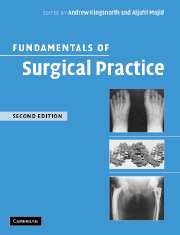Book contents
- Frontmatter
- Contents
- Preface
- Contributors
- 1 Preoperative management
- 2 Principles of anaesthesia
- 3 Postoperative management
- 4 Nutritional support
- 5 Surgical sepsis: prevention and therapy
- 6 Surgical techniques and technology
- 7 Trauma: general principles of management
- 8 Intensive care
- 9 Principles of cancer management
- 10 Ethics, legal aspects and assessment of effectiveness
- 11 Haemopoietic and lymphoreticular systems: anatomy, physiology and pathology
- 12 Upper gastrointestinal surgery
- 13 Lower gastrointestinal surgery
- 14 Hernia management
- 15 Vascular surgery
- 16 Endocrine surgery
- 17 The breast
- 18 Thoracic surgery
- 19 Genitourinary system
- 20 Head and neck
- 21 The central nervous system
- 22 Musculoskeletal system
- 23 Paediatric surgery
- Index
2 - Principles of anaesthesia
Published online by Cambridge University Press: 15 December 2009
- Frontmatter
- Contents
- Preface
- Contributors
- 1 Preoperative management
- 2 Principles of anaesthesia
- 3 Postoperative management
- 4 Nutritional support
- 5 Surgical sepsis: prevention and therapy
- 6 Surgical techniques and technology
- 7 Trauma: general principles of management
- 8 Intensive care
- 9 Principles of cancer management
- 10 Ethics, legal aspects and assessment of effectiveness
- 11 Haemopoietic and lymphoreticular systems: anatomy, physiology and pathology
- 12 Upper gastrointestinal surgery
- 13 Lower gastrointestinal surgery
- 14 Hernia management
- 15 Vascular surgery
- 16 Endocrine surgery
- 17 The breast
- 18 Thoracic surgery
- 19 Genitourinary system
- 20 Head and neck
- 21 The central nervous system
- 22 Musculoskeletal system
- 23 Paediatric surgery
- Index
Summary
Anaesthesia is a non-therapeutic intervention. It is particularly important, therefore, to determine potential benefits and estimated risks. Complications of anaesthesia are poorly tolerated and it is necessary to place safety before pereceived efficacy.
DEFINITIONS
Anaesthesia
Anaesthesia is a reversible state of pharmacologically controlled sleep with reduction in cortical activity. At sufficient anaesthetic depth there is absence of conscious awareness and recall, and no sensory, motor or autonomic response to stimulation.
Balanced anaesthesia
This term is used to illustrate an equilibrium between the three constituents of an anaesthetic: anaesthesia (sleep), analgesia and paralysis. The three interact and the separation is more conceptual than clinical.
Sedation
Sedation is a state of sleepiness but preserved consciousness. Ideally, there is awareness and response to simple commands with verbal contact, but also a degree of amnesia and reduced anxiety.
STAGES OF CLINICAL ANAESTHESIA
In the 1920s four stages of progressively deeper anaesthesia were described in relation to inhalational induction. Drugs and techniques have changed considerably since and it is difficult to distinguish these stages clearly in modern anaesthesia.
Analgesia
This is the stage of inhalational sedation prior to loss of consciousness.
Excitement
The breathing slowly becomes more erratic; the airway is irritable. There may be uncontrolled movements of the limbs.
Surgical anaesthesia
Classically, this consists of four ‘planes’:
Small, pinpoint pupils; the tidal breaths are large and regular; the pharyngeal and vomiting reflexes are depressed.
Pupils are slightly larger; breathing remains regular; the corneal reflex is depressed.
[…]
- Type
- Chapter
- Information
- Fundamentals of Surgical Practice , pp. 16 - 38Publisher: Cambridge University PressPrint publication year: 2006
- 1
- Cited by



